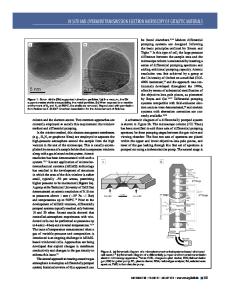Atomic-scale insights into the formation of 2D crystals from in situ transmission electron microscopy
- PDF / 4,912,680 Bytes
- 9 Pages / 612 x 808 pts Page_size
- 14 Downloads / 369 Views
U-FEI Nano-Pico Center, Key Laboratory of MEMS of Ministry of Education, Southeast University, Nanjing 210096, China Center for Advanced Materials and Manufacture, Southeast University-Monash University Joint Research Institute, Suzhou 215123, China
© Tsinghua University Press and Springer-Verlag GmbH Germany, part of Springer Nature 2020 Received: 29 May 2020 / Revised: 30 July 2020 / Accepted: 4 August 2020
ABSTRACT Two-dimensional (2D) crystals are attractive due to their intriguing structures and properties which are strongly dependent on the synthesis conditions. To achieve their superior properties, it is of critical importance to fully understand the growth processes and mechanisms for tailored design and controlled growth of 2D crystals. Due to the high spatiotemporal resolution and the capability to mimic the realistic growth conditions, in situ transmission electron microscopy (TEM) becomes an effective way to monitor the growth process in real-time at the atomic scale, which is expected to provide atomic-scale insights into the nucleation and growth of 2D crystals. Here we review the recent in situ TEM works on the formation of 2D crystals under electron irradiation, thermal excitation as well as voltage bias. The underlying mechanisms are also elucidated in detail, providing key insights into the nucleation and formation of 2D crystals.
KEYWORDS two-dimensional crystal, in situ transmission electron microscopy, formation mechanism, electron irradiation
1
Introduction
Two-dimensional (2D) crystals with ultrathin thickness, which have been among the most studied materials since the discovery of mechanically exfoliated graphene in 2004 [1], are promising fundamental building blocks in the next-generation electronics and optoelectronics due to their unique geometry and extraordinary properties [2–5]. The properties of 2D crystals are expected to be determined by their morphology and crystal structure [6], so the capabilities for the synthesis of designed 2D crystals are of critical importance for the further study of their properties as well as exploration of potential applications. Up to now, various synthesis methods have been developed, such as top-down exfoliation, thermal decomposition, chemical vapor deposition (CVD), solution synthesis and so on [7–9]. Although the shape, size and uniformity can be tuned to a certain extent by modifying experimental parameters such as temperature, chemical reagents, concentrations, etc., the underlying growth mechanisms are still not fully understood because most of these methods are not suited to perform real-time observations with high spatial resolution. The lack of dynamical observation of nucleation and growth processes may make the synthesis mechanism inferred from ex situ characterizations unconvincing. In recent years, some in situ characterization techniques have been developed, such as in situ X-ray absorption fine structures (XAFS), in situ X-ray diffraction (XRD), in situ transmission electron microscopy (TEM), and so on [10]. Among them, in situ TEM
Data Loading...











